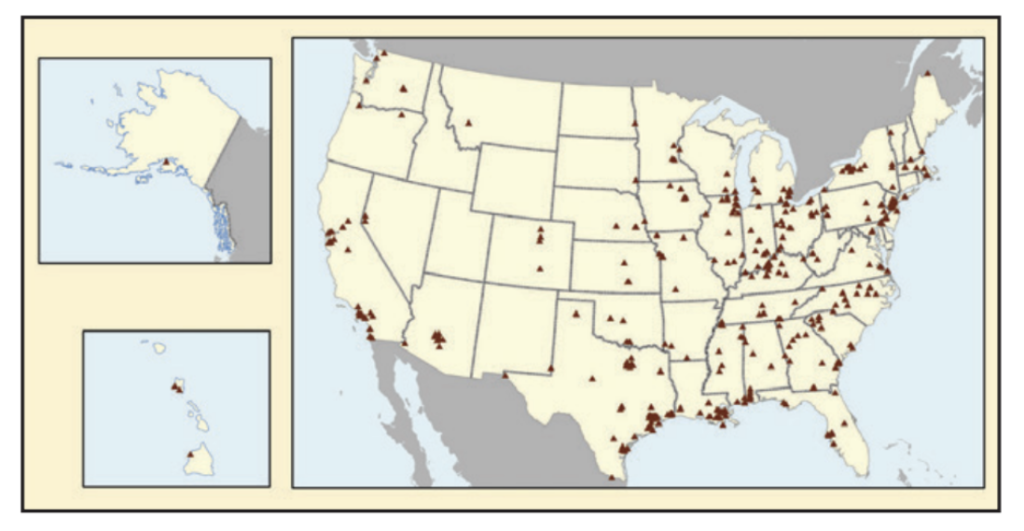

Responsible researcher: Eduarda Miller Figueiredo
Original Title: Why Special Economic Zones? POLICY TO DISCRIMINATE ACROSS IMPORTERS
Author: Matthew Grant
Intervention Location: United States
Sample size: 553 approvals
Sector: Public Sector
Main interest variable: approvals
Intervention Type: Special Economic Zone
Methodology: MQO
Summary
Special Economic Zones (SEZS) are areas located outside the customs border of a country, where there is a reduction or elimination of tariffs on selected intermediate goods for industrial companies operating in the area. Present in many countries, these zones annually produce $ 7.5 billion in gross production. The main objective of this article is to evaluate this policy in the United States, analyzing whether the government can discriminate tariffs among importers. Using a model of Ordinary Squares (OLs) with various controls, the results suggest that Sezs can influence government decisions regarding tariffs.
Special Economic Zones (SEZS) are areas that are outside the customs border of a country, although they are located in sovereign territory and in which companies need government permission to operate. In these zones there is a reduction or elimination of tariffs on intermediate goods selected for industrial companies operating in the area.
Sezs are present in many countries (almost out of all countries) and produce $ 7.5 billion annually in gross production (BOYEGA, 2007). In the United States, Sezs house about
all production. More than
taxable imports enter the US through these areas, leading to postponement of $ 17 million in tax rights from 2011 to 2015.
Sezs are starting to draw attention, as potential catalysts for development and are actively promoted by the World Bank (Alder, Shao and Zilibotti, 2016). Nevertheless, they are not yet well understood. And it is in this lack of understanding that the article studied here is focused: to answer the most fundamental questions, among it: " Why do special economic zones exist? "
A great variation in the rules between countries and the specificities of politics and their real implementation. The central idea of the article that evaluates this policy in the United States is that the government may prefer to charge different rates to different users of the same good -a tariff discrimination between importers -.
In the United States, special economic zones involve only tariff reductions, creating a two -level tariff system: a Sze company can face a lower rate on a particular product than the predominant tariff faced by other buyers of the same product. The granting of selective tariff reductions to a consumer subset allows the government to get a certain transfer of surpluses to producers with less distortion than it would be possible under a uniform fare.
The author brings an example to assist in a better understanding of what Sze would be. Knowing that tariffs are used by the government to increase the prices of national producers of intermediate goods, if there are imports in equilibrium at a certain tariff level, then the government can release some purchases from the fare without changing the price received by national producers. Not releasing a very large number of buyers, the domestic market will be stable at the same price as before. This makes the fare a redistributive instrument more efficient, that is, ideal from the point of view of the political decision -making.
The Special Economic Zones program in the United States is economically very important. There are over 300 USAs from the US, as can be seen in Figure 1. All permissions granted to companies located in these zones are public information, which allowed to build a comprehensive data set. An important detail is that zones in the US is not based on site, which allowed the author to separate the motivations related to the rates from the questions about the location or other policies that are grouped under the same name.
Figure 1: Active Manufacturers in Special Economic Zones (SEZs) in the United States, 2011-2014

Source: Grant (2020) - Data compiled by the author; Puerto Rico was excluded.
The production of companies located in these zones is focused on refining oil and closely related petrochemical products, vehicle production, pharmacists and machinery. Registration for manufacturing in a zone is a complicated process that can take a year or more because of the need to justify products and inputs that you want to obtain tariff reductions and which products you will produce using these inputs.
The data used by the author is composed of two partially overlapping components:
Therefore, if there are 553 approvals. Some complementary calculations and data were also used to investigate the characteristics of the sector, such as political weights (OSSA, 2014; Grossman and Helpman, 1955).
where the variable of interest is , which indicates whether the company active in any year between 2011-2015 is allowed to use the input-product in a special economic zone. The rest of the model are variables that control the demand elasticity of the demand, the political force of the final goods industry and the tariff rule that protects the industry from final goods.
Another analysis was if exogenous increases in the volume of imports of a given intermediate good should lead to subsequent increases in the volume of use of this intermediary with tax rights reduction permitted through Szes.
Main Results
The results suggest that industries that are politically strong and use a particular intermediate product compared to other users are more likely to obtain tariff reductions for this intermediate product through an SZE. ad valorem equivalent goods are less likely to obtain reductions. The results are robust to the inclusion of controls that capture the effects of manipulation of exchange terms or outsourcing considerations on SZes approvals.
For the second analysis, the results suggest that the coefficients of lagged import volumes are positive and significant. That is, this reflects an important institutional detail of the SEZE program in the United States, where almost all approvals are permanent. As a result, the political decision -making will avoid the expansion of Szes in response to temporary shocks -for example, falls in the world price resulting from economic cycles -but should expand in response to permanent change in imports.
The use of special economic zones can affect government choices on tariffs. These changes may have major consequences for well-being, as Szes can change the level of tax rates, as well as exempt some users.
References
Alder, Simon, Lin Shao, and Fabrizio Zilibotti. 2016. Journal of Economic Growth 21 (4): 305–49.
BOYEGE, Jean-Pierre Singa. 2007. “Ilo Database on Export Processing Zones (Reviewed).” Unpublished.
Grossman, Gene M., and Elhanan Helpman. 1995b. “Trade Wars and Trade Talks.” Journal of Political Economy 103 (4): 675–708.
OSSA, Ralph. 2014. “Trade Wars and Trade Talks with Data.” American Economic Review 104 (12): 4104–46.